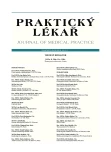Gender differences in food preferences in adolescents - are they projected into consumption?
Authors:
J. Fiala 1,2; L. Kukla 3
Authors‘ workplace:
Lékařská fakulta Masarykovy univerzity, Brno, Ústav preventivního lékařství, Vedoucí: prof. MUDr. Derflerová Brázdová, DrSc.
1; Fakultní nemocnice u sv. Anny v Brně, Mezinárodní centrum klinického výzkumu, Vedoucí: doc. MUDr. Tomáš Kára, PhD.
2; Přírodovědecká fakulta Masarykovy univerzity, Brno, Centrum pro výzkum toxických látek v prostředí - Recetox, Vedoucí: prof. RNDr. Ivan Holoubek, CSc.
3
Published in:
Prakt. Lék. 2012; 92(7): 407-413
Category:
Of different specialties
Overview
Introduction:
Nutrition greatly affects health, and therefore it is important to identify the factors that determine the choice and composition of the diet. These include food preferences. The aim of the study was to determine whether food preferences differ between both sexes, and how much they are reflected in the consumption.
Methods:
Both food preferences and consumption frequency for 56 foods and beverages were investigated by use of a questionnaire in a sample of 1665 adolescents aged 15 years in Brno. The differences between the sexes were subsequently analysed.
Results:
Food preferences differ significantly between the sexes and the preferences of the girls can be described as being significantly healthier. From the top-ten list of the most preferred foods, 6 items are consistent with healthy diet in girls, while only 2 items in boys. Girls significantly more positively perceive raw vegetables, cereal products and fresh fruit, and, conversely, they perceive more negatively lard, hamburgers, processed meats, red meat, offal and carbonated soft drinks. Gender differences in the preferences were statistically significant in 48 % of the items. As for consumption, the gender differences are much smaller than with the preferences. The top-ten of the most consumed items is completely identical for both sexes; it only differs in the order. Also among the least consumed items there is a good concordance between sexes, 8 items from 10 are the same. From the top-ten of the most preferred items, only 1 item (fresh fruit) is among the top-ten of the most consumed foods in boys, and 3 items (fruit, raw vegetables, cheese) in girls.
Conclusion:
In adolescents, we found significant gender differences in food preferences, where the preferences of girls were much closer to healthy diet. However, the preferences are not readily reflected in consumption. Consumption differs significantly from preferences in so much as that consumption is much closer to a healthy diet. Unlike the preferences, the gender differences in consumption are only very small. The results show that the food choice in both sexes is very modifiable by external factors, which can suppress even the gender differences in food preferences.
Key words:
nutrition, diet, gender differences, food preferences, consumption, adolescents
Sources
1. Benton D. Role of parents in the determination of the food preferences of children and the development of obesity. Int J Obes Relat Metab Disord, 2004; 28(7): p. 858–869.
2. Breen F, Plomin R, Wardle J. Heritability of food preferences in young children. Physiol Behav, 2006; 88(4-5): p. 443-447.
3. Brug J, Tak N, Velde S, et al. Taste preferences, liking and other factors related to fruit and vegetable intakes among schoolchildren: reults form observational studies. Br J Nutr, 2008; 99(Suppl.1): 7–14.
4. Caine-Bish NL, Scheule B. Gender differences in food preferences of school-aged children and adolescents. J Sch Health, 2009; 79(11): p. 532–540.
5. Cooke LJ, Wardle J. Age and gender differences in children’s food preferences. Br J Nutr, 2005; 93(5): p. 741–746.
6. Harris G. Development of taste and food preferences in children. Curr Opin Clin Nutr Metab Care, 2008; 11(3): p. 315–319.
7. Nicklaus S, Boggio V, Chabanet C, Issanchou S. A prospective study of food preferences in childhood. Food Qual Prefer, 2004; 15(7-8): p. 805–818.
8. Russell CG, Worsley A. Do children’s food preferences align with dietary recommendations? Public Health Nutr, 2007; 10(11): p. 1223–1233.
9. Ton Nu Ch, MacLeod P, Barthelemy J. Effects of age and gender on adolescents’ food habits and preferences. Food Qual Prefer, 1996; 7(3-4): p. 251–262.
10. Wądołowska L, Babicz-Zielińska E, Czarnocińska J. Food choice models and their relation with food preferences and eating frequency in the Polish population: POFPRES study. Food Policy, 2008; 33(2): p. 122–134.
Labels
General practitioner for children and adolescents General practitioner for adultsArticle was published in
General Practitioner

2012 Issue 7
Most read in this issue
- Bradykinin-induced angioedema and its differential diagnosis
- Evaluating the validity of select fall risk assessment tools in hospitalized elderly
- Sublingual allergen immunotherapy – progress in the treatment of allergic rhinitis and conjunctivitis
- So called problem prone patients
